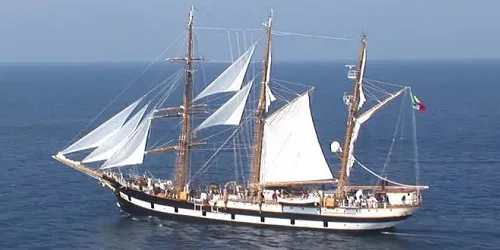-
Register Now for a Free Account!Unlock additional site access with your free account today, takes less than a minute, and guaranteed no spam - ever. Register Now!
Palinuro #7 Oldest Active Military Ship - Cruising Earth

Palinuro - Italian Navy
#7 Oldest Active Military Ship
Palinuro is currently ranked #7 in the list of the Oldest Active Military Ships.
Palinuro Historical Brief
Introduction
The Italian Navy ship Palinuro is a training vessel with a rich history and an important role in the development of Italian naval cadets. Named after the ancient Greek navigator Palinurus from Virgil's "Aeneid," the ship has been instrumental in maintaining maritime traditions and ensuring the professional growth of future Italian naval officers. This historical brief provides an overview of the Palinuro's construction, operational history, training role, and cultural significance.
Construction and Early Years (1934-1955)
The Palinuro was originally built as a French commercial vessel named "Commandant Louis Richard" in 1934. Constructed at the shipyard of Anciens Chantiers Dubigeon in Nantes, France, the ship was designed as a barquentine, a three-masted vessel with a combination of square and fore-and-aft sails. It was initially used for cargo transport, primarily in the French colonial trade.
In 1951, the ship was acquired by the Italian Navy to serve as a replacement for the training ship Cristoforo Colombo, which had been ceded to the Soviet Union as war reparations after World War II. The vessel underwent significant modifications and refitting at the Castellammare di Stabia shipyard in Italy. The transformation included changes to its rigging, accommodation facilities, and navigation equipment to suit its new role as a training ship.
The vessel was renamed Palinuro, in honor of the legendary helmsman of Aeneas. The ship was commissioned into the Italian Navy on July 16, 1955. With a length of 69 meters, a beam of 10 meters, and a draft of 4.8 meters, the Palinuro displaces approximately 1,341 tons. It is rigged with 15 sails covering a total area of around 1,000 square meters, which allows it to harness wind power effectively.
Training Role and Operational History (1955-Present)
From the outset, the Palinuro's primary mission has been to serve as a training vessel for the Italian Naval Academy in Livorno. The ship provides practical seamanship training to cadets, complementing their academic studies. Cadets aboard the Palinuro learn essential skills such as sail handling, navigation, meteorology, and ship maintenance. The hands-on experience gained during training cruises is invaluable in preparing them for their future roles as naval officers.
The Palinuro's training cruises have taken it to numerous ports across the Mediterranean, Atlantic, and even the Baltic Sea. These voyages are designed to expose cadets to a variety of sailing conditions and operational scenarios, fostering their adaptability and resilience. The ship's training missions often include international exchanges with naval academies from other countries, promoting cross-cultural understanding and cooperation.
In addition to its training role, the Palinuro has participated in numerous maritime festivals, tall ship races, and regattas. These events provide opportunities for the ship to showcase Italian maritime heritage and foster goodwill with other seafaring nations. The Palinuro's elegant design and traditional rigging make it a popular and admired participant at these gatherings.
Modernization and Upgrades
Over the years, the Palinuro has undergone several refits and upgrades to ensure its continued operational effectiveness and safety. These updates have included improvements to the ship's hull, rigging, and onboard systems. Modern navigation and communication equipment have been installed to enhance the ship's capabilities while maintaining its historical character.
One significant refit occurred in the early 1980s, during which the ship's original wooden masts were replaced with steel ones to improve durability and safety. The accommodations for cadets and crew were also modernized to provide better living conditions during extended voyages. These upgrades have helped ensure that the Palinuro remains a viable and effective training platform for future generations of naval cadets.
Cultural and Diplomatic Significance
Beyond its role as a training ship, the Palinuro serves as a floating ambassador for Italy. Its visits to foreign ports are often accompanied by cultural events, exhibitions, and public tours, showcasing Italy's rich maritime history and traditions. The ship's presence at international events helps to strengthen Italy's diplomatic ties and promote cultural exchange.
The Palinuro's participation in tall ship races and maritime festivals has also contributed to its international reputation. These events bring together sailing ships from around the world, fostering a sense of camaraderie and mutual respect among seafaring nations. The ship's elegant lines and traditional appearance make it a crowd favorite and a symbol of Italy's commitment to preserving its maritime heritage.
One of the most notable events in the Palinuro's history was its participation in the 500th anniversary celebrations of Christopher Columbus's voyage to the Americas in 1992. The ship joined other tall ships in a grand regatta that commemorated this historic milestone, highlighting Italy's historical contributions to global exploration and maritime knowledge.
Preservation and Future Prospects
As the Palinuro continues to serve the Italian Navy, efforts to preserve its historical integrity and operational capabilities are ongoing. Regular maintenance and periodic refits are essential to ensuring the ship's seaworthiness and safety. These efforts are also crucial in preserving the ship's legacy for future generations of naval cadets and the public.
The future prospects for the Palinuro are promising. The ship will continue to play a vital role in the training of Italian naval officers, providing them with the skills and experience necessary for their careers. Its participation in international events and cultural exchanges will also endure, promoting Italy's maritime heritage and fostering global understanding.
In recent years, there has been a renewed interest in traditional sailing vessels and their role in naval training. The Palinuro's continued service is a testament to the enduring value of hands-on seamanship training and the importance of preserving maritime traditions. The ship's combination of historical charm and modern functionality makes it a unique and invaluable asset to the Italian Navy.
Conclusion
The Italian Navy ship Palinuro stands as a testament to Italy's rich maritime history and its commitment to training and excellence. Since its commissioning in 1955, the ship has trained countless naval cadets, participated in significant historical events, and promoted cultural exchange and diplomacy around the world. As it continues to sail the world's oceans, the Palinuro remains a symbol of Italy's enduring maritime legacy and its dedication to the values of seamanship, tradition, and international friendship.
The Palinuro's historical significance, elegant design, and ongoing role in naval training and cultural diplomacy make it an important and cherished part of the Italian Navy. As it approaches its centenary, the ship's legacy will continue to inspire future generations of sailors and maritime enthusiasts, preserving Italy's rich nautical traditions for years to come.


